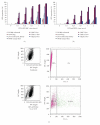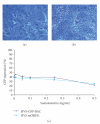Mutation of herpesvirus Saimiri ORF51 glycoprotein specifically targets infectivity to hepatocellular carcinoma cell lines
- PMID: 21197456
- PMCID: PMC3004438
- DOI: 10.1155/2011/785158
Mutation of herpesvirus Saimiri ORF51 glycoprotein specifically targets infectivity to hepatocellular carcinoma cell lines
Abstract
Herpesvirus saimiri (HVS) is a gamma herpesvirus with several properties that make it an amenable gene therapy vector; namely its large packaging capacity, its ability to persist as a nonintegrated episome, and its ability to infect numerous human cell types. We used RecA-mediated recombination to develop an HVS vector with a mutated virion protein. The heparan sulphate-binding region of HVS ORF51 was substituted for a peptide sequence which interacts with somatostatin receptors (SSTRs), overexpressed on hepatocellular carcinoma (HCC) cells. HVS mORF51 showed reduced infectivity in non-HCC human cell lines compared to wild-type virus. Strikingly, HVS mORF51 retained its ability to infect HCC cell lines efficiently. However, neutralisation assays suggest that HVS mORF51 has no enhanced binding to SSTRs. Therefore, mutation of the ORF51 glycoprotein has specifically targeted HVS to HCC cell lines by reducing the infectivity of other cell types; however, the mechanism for this targeting is unknown.
Figures












Similar articles
-
Characterization of the Herpesvirus saimiri Orf51 protein.Virology. 2004 Aug 15;326(1):67-78. doi: 10.1016/j.virol.2004.05.015. Virology. 2004. PMID: 15262496
-
In vivo episomal maintenance of a herpesvirus saimiri-based gene delivery vector.Gene Ther. 2001 Dec;8(23):1762-9. doi: 10.1038/sj.gt.3301595. Gene Ther. 2001. PMID: 11803395
-
Efficient infection and persistence of a herpesvirus saimiri-based gene delivery vector into human tumor xenografts and multicellular spheroid cultures.Cancer Gene Ther. 2005 Mar;12(3):248-56. doi: 10.1038/sj.cgt.7700788. Cancer Gene Ther. 2005. PMID: 15540115
-
Herpesvirus saimiri-based gene delivery vectors.Curr Gene Ther. 2006 Feb;6(1):1-15. doi: 10.2174/156652306775515529. Curr Gene Ther. 2006. PMID: 16475942 Review.
-
Herpesvirus saimiri.Philos Trans R Soc Lond B Biol Sci. 2001 Apr 29;356(1408):545-67. doi: 10.1098/rstb.2000.0780. Philos Trans R Soc Lond B Biol Sci. 2001. PMID: 11313011 Free PMC article. Review.
Cited by
-
Retargeting of viruses to generate oncolytic agents.Adv Virol. 2012;2012:798526. doi: 10.1155/2012/798526. Epub 2011 Nov 14. Adv Virol. 2012. PMID: 22312365 Free PMC article.
References
-
- Roizman B, Carmichael LE, Deinhardt F. Herpesviridae. Definition, provisional nomenclature, and taxonomy. Intervirology. 1981;16(4):201–217. - PubMed
-
- Markert JM, Medlock MD, Rabkin SD, et al. Conditionally replicating herpes simplex virus mutant G207 for the treatment of malignant glioma: results of a phase I trial. Gene Therapy. 2000;7(10):867–874. - PubMed
-
- Senzer NN, Kaufman HL, Amatruda T, et al. Phase II clinical trial of a granulocyte-macrophage colony-stimulating factor-encoding, second-generation oncolytic herpesvirus in patients with unresectable metastatic melanoma. Journal of Clinical Oncology. 2009;27(34):5763–5771. - PubMed
-
- Macnab S, White R, Hiscox J, Whitehouse A. Production of an infectious Herpesvirus saimiri-based episomally maintained amplicon system. Journal of Biotechnology. 2008;134(3-4):287–296. - PubMed
Publication types
MeSH terms
Substances
Grants and funding
LinkOut - more resources
Full Text Sources
Medical

